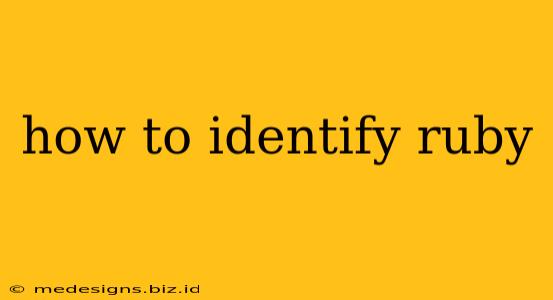Rubies, with their captivating red hues, are highly sought-after gemstones. But how can you be sure the dazzling stone you're looking at is a genuine ruby, and not a cleverly disguised imitation? This guide will equip you with the knowledge to confidently identify rubies, whether you're a seasoned collector or a curious beginner.
Visual Inspection: The First Step to Ruby Identification
The most immediate way to assess a ruby is through visual inspection. While this isn't foolproof, it's a crucial first step.
Color:
- The Defining Characteristic: The hallmark of a ruby is its intense red color, often described as "pigeon blood red." This vibrant shade stems from the presence of chromium in the corundum structure. Variations in chromium content lead to different shades of red, ranging from purplish-red to reddish-pink. Be wary of stones with overly bright or unnatural-looking red colors, as these could be synthetic or treated.
Clarity and Inclusions:
- Look for imperfections: Natural rubies almost always contain inclusions – internal flaws or imperfections. These inclusions are like fingerprints, unique to each stone and a key indicator of authenticity. While perfectly clear rubies exist, they are extremely rare and expensive. The presence of these natural imperfections is often a positive sign of genuine ruby. Synthetic rubies, on the other hand, tend to be much clearer.
Cut and Polish:
- Assess the craftsmanship: Examine the stone's cut and polish. High-quality rubies are usually well-cut to maximize brilliance and fire. Poorly cut or poorly polished stones could suggest an imitation or low-quality ruby.
Beyond Visual Inspection: Advanced Testing Methods
While visual inspection provides a good initial assessment, more definitive identification requires additional testing.
Specific Gravity Test:
- Density matters: Rubies have a relatively high specific gravity (around 4.0). This means they are denser than many other gemstones. A simple specific gravity test can help differentiate a ruby from lighter imitations.
Refractive Index Test:
- Light refraction: Rubies have a characteristic refractive index, which measures how light bends as it passes through the stone. A refractometer can accurately measure this index, helping to confirm the identity of the ruby.
Hardness Test:
- Scratch resistance: Rubies rank 9 on the Mohs Hardness Scale, indicating high scratch resistance. This test involves trying to scratch the stone with a harder material (like a diamond). A genuine ruby will not be scratched easily. Caution: This test should be performed by a professional gemologist to avoid damaging the stone.
Spectroscope Examination:
- Spectral fingerprint: A spectroscope analyzes the light absorption patterns of the stone. Rubies exhibit distinctive spectral lines, providing a definitive confirmation of their identity. This is a more sophisticated method best left to gemologists.
Distinguishing Rubies from Imitations and Treatments
Several materials are used to imitate rubies or enhance their color. Here are some key differences:
-
Synthetic Rubies: These are lab-grown rubies with similar chemical composition to natural rubies. They often lack the characteristic inclusions found in natural stones and may possess unusually high clarity. Advanced testing is usually needed to distinguish them from natural rubies.
-
Glass Imitations: These are significantly less dense and hard than rubies. A simple scratch test or specific gravity test can easily reveal their identity.
-
Spinel: Sometimes mistaken for rubies, spinels are distinct gemstones with different optical properties.
-
Ruby Treatments: Some rubies undergo heat treatment to improve their color. While heat treatment is common and generally acceptable, it's crucial to know if a stone has been treated, as it may affect its value.
Seeking Professional Expertise
For conclusive identification and valuation, it's highly recommended to seek the services of a qualified gemologist. They have the expertise and equipment necessary to perform rigorous testing and provide a reliable assessment of your ruby. Don't risk purchasing a potentially valuable stone without professional verification.
By following these steps and seeking professional assistance when necessary, you can confidently identify genuine rubies and appreciate the beauty and value of these remarkable gemstones.
